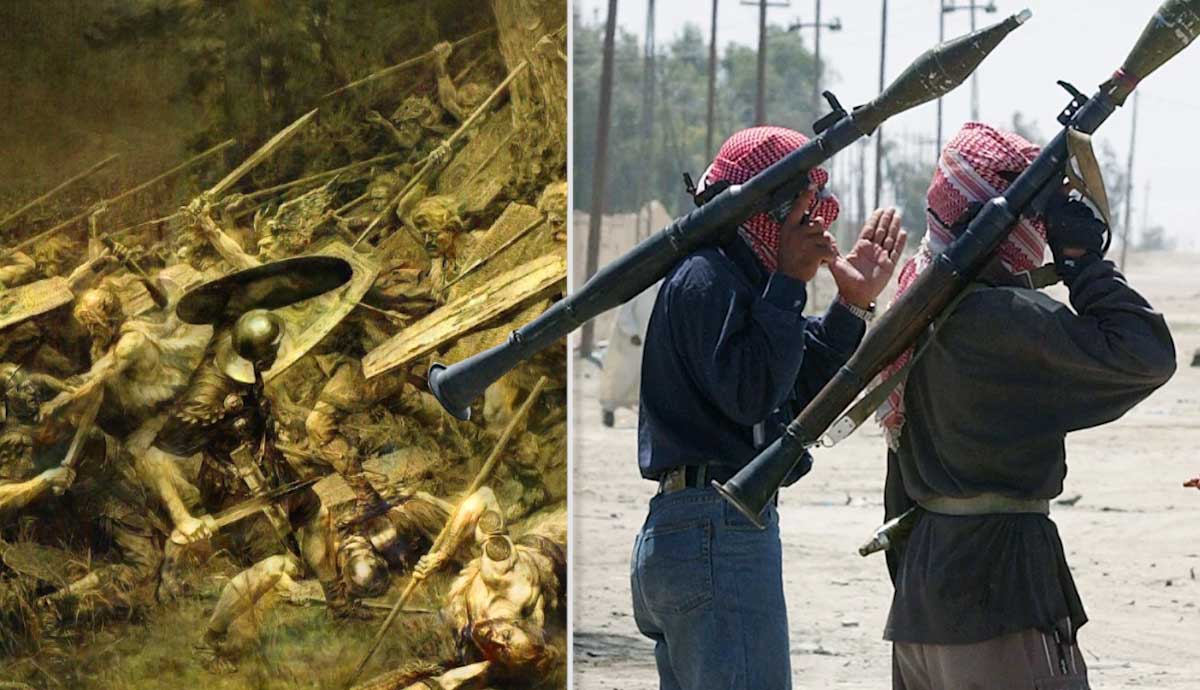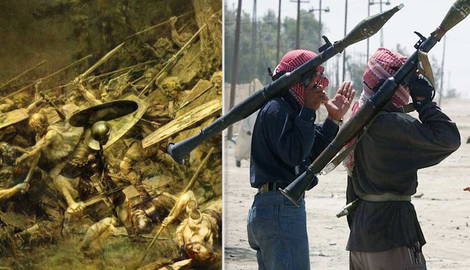
Throughout the long history of humanity, people have always found more and more ingenious ways to kill each other. Techniques and tactics have been employed on a wide range of battlefields, from an open field to room-by-room clearance of buildings. One issue that has been repeated throughout the history of conflict is the challenge faced by a smaller group in overcoming a larger force. One way that a smaller and less-well equipped group can overcome a larger, orthodox force is through the use of guerrilla warfare. This technique was effectively applied by the tribesmen of Germania during the battle of Teutoburg Forest and also by insurgents in the modern-day Iraq War.
Guerrilla Warfare Explained

Guerrilla warfare comes from the Spanish word guerra, meaning war, and is used to describe small-scale and fast-moving insurgent forces fighting against often larger and better-equipped armies. The techniques employed by insurgents include ambush attacks, traps, and sabotage that can overcome the superior training, equipment, and numbers of the opposition.
The term was first used to describe the Spanish and Portuguese guerrilleros that drove the French from Iberia during the Peninsular War (1808-14). Through constant harassment of the Napoleonic army, the guerrilleros were able to draw the attention of the French away from the regular armies of the British, leaving them open to attack.
The Battle of Teutoburg Forest (9 CE)

One of the prime examples of guerrilla warfare comes from the 9 CE Battle of Teutoburg Forest in which a small group of Germanic tribesmen defeated the might of three Roman legions. The former Legate of Syria, Publius Quinctilius Varus, was placed in command of the XVII, XVIII and XIX legions with the goal of expanding the Roman Empire into the land of Germania, modern-day Germany.
The main adversary to Rome in Germania was the tribal leader Arminius, who had received Roman auxiliary training before defecting back to the Cherusci tribe in response to the invasion of his homeland. Leading an alliance of tribes and with a detailed first-hand knowledge of Roman battle tactics, Arminius was able to effectively counter the Roman advance and use guerrilla warfare to turn the terrain against the legions.

To prepare for the incoming invasion, Arminius had a large sand and turf rampart constructed in Kalkriese around the naturally heavily forested and boggy terrain that funneled the long column of soldiers and baggage train into a bottleneck ready for the slaughter.
As the rain began to pour, water flooded down from the hills into the narrow valley that the Roman legions were marching through. The slippery and boggy conditions stalled the soldiers and provided no opportunity to utilize any effective Roman battle formations. Lightly armored tribesmen came flying down the hillside and struck the heavily armored and stranded Romans, killing thousands in the process. After seeing that the battle was lost, many Roman commanders, including Varus himself, fell upon their own swords.
The Archaeology of Kalkriese

In order to support the historical accounts of the battle by historians such as Cassius Dio, it is important to also consider the archaeology of the site. As well as human remains, many pieces of Roman military equipment have been discovered, such as sections of a lorica segmentata (a Roman cuirass). Pieces of armor and many weapons have also been excavated, such as spearheads and daggers that were all found in the same layer suggesting that they were deposited at the same time and during one event.
Archaeological evidence of the rampart has also been discovered. The Varusschlacht Museum und Park has also created a modern reconstruction of how the rampart was built to give visitors an idea of how the Cherusci would have hidden behind it while attacking the Roman legions. The rampart would have provided a strong defensive position on top of the hills to give the advantage of height to the tribesmen.
Guerrilla Warfare in the Iraq War

Although centuries have passed since the time of Arminius, many of the techniques that were utilized by the Germanic tribes at Teutoburg are still being employed. Surprise, sabotage, and ambushes are still used by small groups against larger occupying forces. Such military tactics were also observed during the Iraq War (2003-11), where Iraqi insurgents used shelter and improvised weapons to attack the Coalition forces led by the United States.
The scene was set for the Iraq War after the conclusion of Operation Desert Storm in 1991, which saw Saddam Hussein remain in power until the Iraq War of 2003. The initial phase of the Iraq War was conducted predominantly between the Coalition forces and the Iraqi military and included heavy artillery and air strikes on military and government complexes. This was followed by the taking of the major cities of Tikrit, Baghdad, and Basra.

After the initial military success, Iraqi insurgent forces began a campaign of guerrilla warfare against the Coalition troops. This second phase of the war led to thousands of civilian and military casualties and presented an increasing challenge to the Coalition forces. The change in tactics allowed the smaller Iraqi force to resist for a longer period of time than the military had managed through traditional warfare.
One of the main techniques the Iraqi insurgents used was the employment of improvised exploding devices (IEDs). An IED is a ‘homemade’ exploding device that is often detonated using a remote trigger system meaning that insurgents did not have to expose themselves to risk. These devices caused around half of the combat deaths and casualties during the war and were proven to be extremely effective against the Coalition forces in terms of incapacitating soldiers and destroying vehicles and equipment.
The Weapons of the War in Iraq

The archaeological remains of these devices have been analyzed in order to understand their function and to create effective countermeasures. These studies are also useful for reconstructing the picture of their use from an archaeological point of view.
The advancement of IED technology includes the creation of trigger systems such as mobile phones and garage door openers to manually detonate them from afar. Pressure plates, tripwires, and the compression of rubber hoses were also ways that the target could trigger the trap.
The technology applied by the Iraqi insurgents clearly shows an advancement in the tactics of guerrilla warfare while still retaining the key principles such as ambush and sabotage. The superior defensive armor of the Coalition forces could be rendered obsolete when an IED was detonated beneath the vehicle; the bottom armored plate of a Bradley Fighting Vehicle was found 60 yards from the initial blast area on one occasion.

Advancements in the use of guerrilla warfare can also be seen in the use of biological and psychological warfare in order to cause lasting injury after the initial attack but also to instill fear into the enemy before they have even arrived at the ambush location. The use of IEDs was also effective in terms of causing psychological damage to the soldiers due to the fear of running into one but also through the development of mental disorders such as Post-Traumatic Stress Disorder (PTSD). This played a part in impairing the duties of the soldiers.
Another aspect of advancement comes from a similar example in Afghanistan, where the use of biological warfare was evidenced by the placement of an IED near a stream polluted with raw sewage. This led to a soldier developing sepsis and other conditions due to the bacteria in the water, which many conventional antibiotics failed to treat. This is a more advanced form of guerrilla warfare as it demonstrates a knowledge of biology in order to increase the effectiveness of the initial explosion with a longer-lasting impact.
Through the use of guerrilla warfare, the insurgents were able to use their detailed knowledge of the local terrain to plant IEDs in the landscape in order to halt the advance of the regular Coalition military forces. This clever use of terrain and concealment allowed them to avoid confronting the Coalition forces in open warfare, which in turn allowed the smaller force to resist for a longer period.
Guerrilla Warfare in Teutoburg and Iraq
The battle of Teutoburg Forest and the Iraq War are good examples of guerrilla warfare tactics by a smaller force charged with defending against a better-equipped, professional army.
The tribesmen used the landscape effectively to overpower the Romans after trapping them in a bottleneck by modifying the terrain with a rampart. The insurgents in Iraq used their terrain equally effectively by leading vehicles to a point where strategic IEDs had been placed to cause maximum damage.
Guerrilla warfare heavily relies upon the fear of ambush in order to be a successful technique which is why it has been used again and again throughout history by a smaller force trying to resist a larger and more orthodox army.








